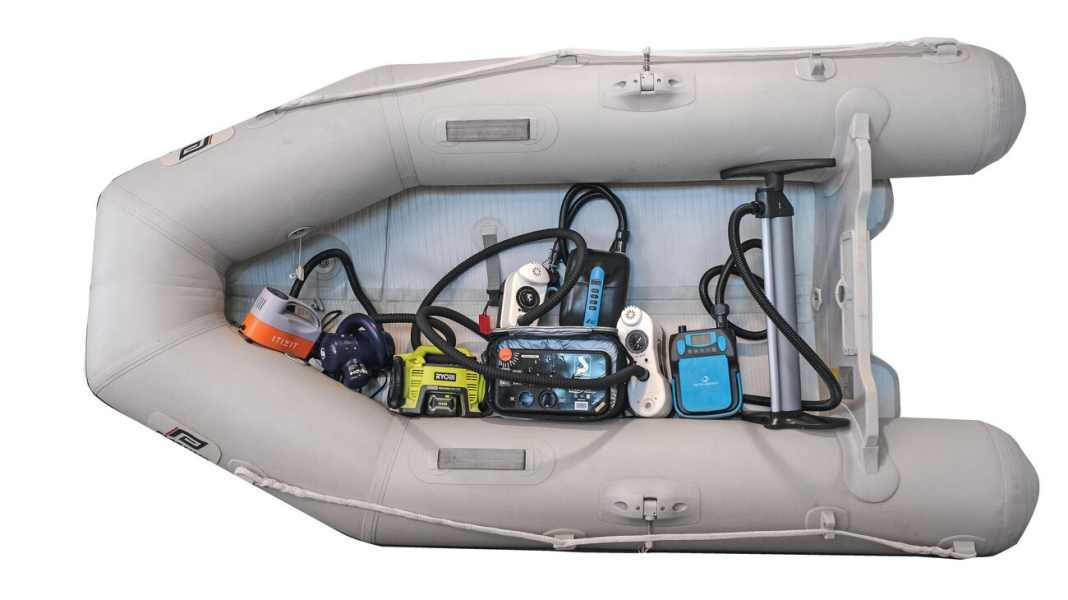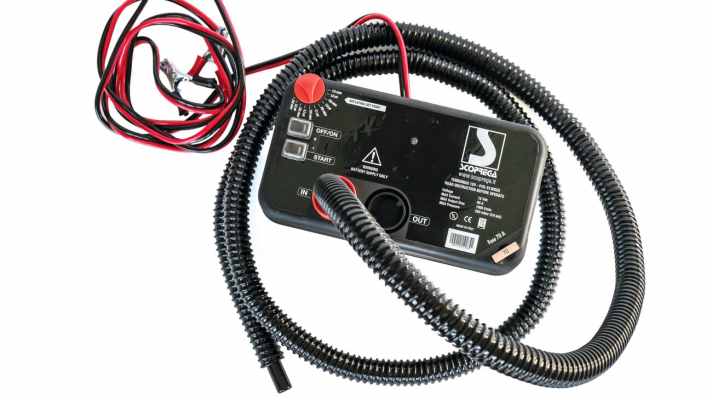
One of the best endings to a day's cruising is probably when the anchor drops in a sheltered bay. However, if you need to take the dog for a walk or want to go ashore to fetch bread rolls in the morning, you will need the dinghy, which in most cases means the inflatable boat. And that often means inflating it. Although the small dinghy can be quickly inflated with a hand pump, you'll want mechanical assistance when you're using a high-pressure floor or SUP. Electric pumps, which are the subject of this test, are a practical aid.
There is a system-related problem: a pump alone cannot usually achieve a large volume at high pressure. A blower can move a lot of air per minute, but cannot create the necessary pressure. The opposite is true for a compressor with a piston pump. For example, it can fill the SUP with the necessary pressure, but this usually takes quite a long time. Many manufacturers therefore combine the two and install both a blower and a compressor. If the pressure becomes too high for the former, the control system simply switches to the compressor. Ideally, all you need to do is connect the hose, set the desired pressure and then press start. The pump then takes care of everything else. When selecting the test devices, the range offered by the relevant equipment suppliers was therefore the first choice. There are many pumps from the Italian company Scoprega. They differ in terms of performance and area of application. The hand pump for comparison also comes from this company and is included with many SUPs and inflatable boats as original equipment. In addition to the boat suppliers, pumps from sporting goods retailer Decathlon, electronics retailer Pearl, Bauhaus and Kaufland were also included in the test field.
The choice is not easy, as there are many more products on the market. These are designed for inflating everything from air mattresses to bicycle and car tyres, but are not necessarily suitable for the dinghy and SUP requirements formulated at the beginning. This is why the pumps from Einhell and Trotec were not rated. The test and a look at the operating instructions reveal that they are not intended for use on board. Another pump did not make it into the test field either: The Turbo Max model from Scoprega is very large and intended for fixed installation in the forecastle. It can fill the dinghy in record time, but achieves a maximum pressure of 250 millibars - enough for the dinghy's hoses, but not enough for the high-pressure floor. It also draws an incredible 61 amps of power from the battery. This power blower is more suitable for filling large inflatables, not for use on board. We did not test very simple blowers, some of which are available for less than 30 euros. These models do not have a pressure gauge and do not reach the 0.8 bar required for a high-pressure floor. This makes them unsuitable for clearing the dinghy.
Four models - those from Einhell, Ryobi, Fun Sports and Trotec - are equipped with a rechargeable battery; all others draw their power from a 12-volt connection. It is important to know how much power the pump needs. Anything under 10 amps can be safely operated via a cigarette lighter. However, the cable cross-sections are usually not designed for more current. And even if they are, the contact surfaces in the cigarette lighter are quite small and form a high resistance, with the result that the plug becomes very hot at higher currents. Although this only occurs when the compressor takes over, with SUPs this phase can last for many minutes. It is then advisable to connect pumps that draw significantly more than 10 amps directly to the battery. This is why this aspect is also given 20 points in the assessment. For pumps with a rechargeable battery, there is no need to worry about power consumption when inflating. Extra points are awarded for the battery models.

Even if the pumping process does not usually last more than 15 minutes and the power consumption is therefore limited, it may make sense with small consumer batteries not to switch off the machine immediately after the anchoring manoeuvre, but to leave it running.
In addition to this safety aspect, the speed with which the dinghy and SUP are ready for use is of course the most important factor in the assessment. The fastest models are awarded 50 points. In the case of the dinghy, the pure pumping process must not take longer than six minutes for a very good rating, and no longer than nine minutes for the SUP. The dinghy had several air chambers and the time required to reconnect the hose is not included in the calculation. The fastest was the Sevylor model from AWN, closely followed by the AGT from Pearl, the Scoprega brand GE BTB from SVB and the Spinera Fun Sports from the supplier Lindemann. The latter is the test winner. However, the good models are close together at the top.
It is worth looking to the right of the table at the hand pump: No electric pump can beat it in the time ranking. To be fair, it should be noted that the hand pump was used to pump really quickly.
You are correspondingly exhausted afterwards, especially when SUPing. The high pressure as you approach one bar (roughly equivalent to 15 psi) requires a lot of strength. That's why electric pumps don't win the race against the clock, but they certainly win in terms of comfort. The hand pump offers another advantage: lower noise levels. Especially when the electric pumps switch to compressor mode, they can be very loud. The inglorious leader here is the GE BP from Scoprega with 115 decibels. By way of comparison, this puts it on a par with a chainsaw and rock concerts. This particular model also produced an unpleasant screeching noise, which only diminished when the pressure increased, i.e. shortly before the end. Hearing protection is strongly recommended at this volume. In any case, it disturbs the peace and quiet of the anchorage considerably, which is why there is a point deduction in the rating.
In addition to important criteria such as time and power consumption, small details are also relevant. The pumps from Scoprega, for example, all offer high-quality hoses. The electric pump from Itiwit, for example, constantly tipped over because the hose is quite inflexible and not particularly long. The designs of the test winner and the price-performance tip from Fun Sports and Pearl are particularly comfortable. On both models, the thread for attaching to the pump can be rotated on the hose, so you don't have to turn the whole hose. Here again, the Itiwit model stood out negatively. The bayonet lock for the HR valves on the dinghy and SUP was also secured to the hose, but in the opposite direction. This connection opened unintentionally as soon as the hose was connected to the dinghy. All in all, the pump didn't work badly, but this small detail was annoying. Another "nice to have" feature is the actual pressure display. This shows the pressure already reached during the pumping process. This makes it easy to estimate how much longer it will take. All models apart from the GE BP from Scoprega offered this feature. The slightly larger sister model GE BTB from SVB does it particularly elegantly: the target pressure is preset analogue on the outer rotating ring, and the actual pressure can be read on the pointer instrument during operation. Detecting leaks is another advantage of the pressure gauge with actual pressure display: if the pressure stagnates, the problem can be recognised earlier and troubleshooting can begin. Almost all test models switched off when the target pressure was reached. Only the battery-powered compressor One+ from Ryobi did not do this, although the function should be available according to the operating instructions. On board, the pump is not suitable for the large volumes of dinghy and SUP. It was able to fill the dinghy, albeit slowly; we cancelled the SUP test after just under 25 minutes. The pressure did not rise any further and the adapter did not close tightly.
In terms of price, the test field is quite heterogeneous, with the test winner being by far the most expensive. Surprisingly, the hand pump is not the cheapest product. On the other hand, it offers free warm-up training before getting on the SUP or inflatable boat.
Need more information? You can find the air pump test with more pictures, detailed measurement results and a full evaluation in BOOTE issue 07/2022 - available from newsagents from 15 June 2022 or online directly in the Delius Klasing Shop.

